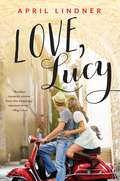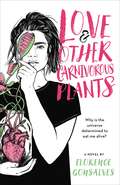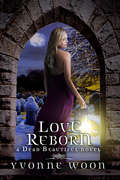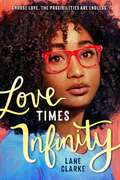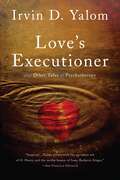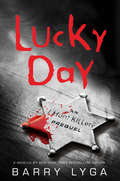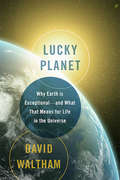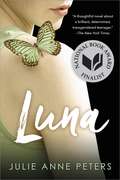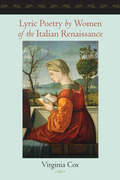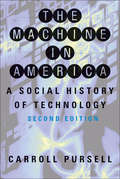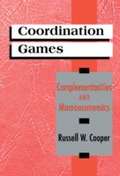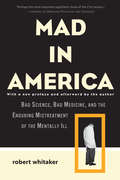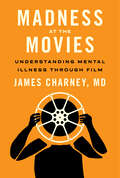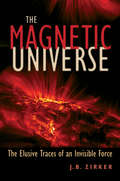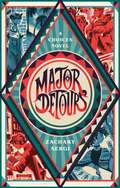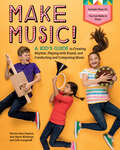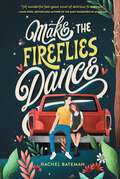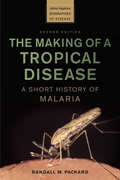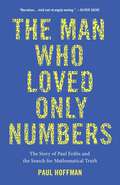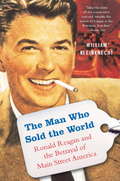- Table View
- List View
Love, Lucy: A Love, Lucy Novella
by April LindnerWhile backpacking through Florence, Italy, during the summer before she heads off to college, Lucy Sommersworth finds herself falling in love with the culture, the architecture, the food...and Jesse Palladino, a handsome street musician. After a whirlwind romance, Lucy returns home, determined to move on from her "vacation flirtation." But just because summer is over doesn't mean Lucy and Jesse have to be, does it?In this stunning novel, April Lindner perfectly captures the highs and lows of a summer love that might just be meant to last beyond the season.
Love & Other Carnivorous Plants
by Florence GonsalvesThis acclaimed, darkly funny debut for fans of Jesse Andrews and Robyn Schneider about a teen who's consumed by love, grief, and self-destructive behavior is now in paperback. Freshman year at college was the most anticlimactic year of Danny's life. She's failing pre-med and drifting apart from her best friend. One by one, Danny is losing all the underpinnings of her identity. When she finds herself attracted to an older, edgy girl who she met in rehab for an eating disorder, she finally feels like she might be finding a new sense of self. But when tragedy strikes, her self-destructive tendencies come back to haunt her as she struggles to discover who that self really is. With a starkly memorable voice that's at turns hilarious and heartbreaking, Love and Other Carnivorous Plants brilliantly captures the painful turning point between an adolescence that's slipping away and the overwhelming uncertainty of the future.
Love Reborn (A Dead Beautiful Novel)
by Yvonne WoonThe heart-pounding, romantic conclusion to the Dead Beautiful series by Yvonne Woon.Renée and Dante are dying. The soul they share cannot sustain them both, and they're quickly running out of time. But Renée has in her possession a legendary chest said to contain the secret to eternal life...if only they could solve the clues that lie within it. With both the Liberum, a Brotherhood of the Undead, and a team of Monitors—led by Renee's own grandfather—in hot pursuit, Renée and Dante must keep the chest from falling into the wrong hands. With the help of a mysterious letter-writer called only Monsieur, Renée and Dante follow a series of clues that lead them on a treacherous journey across Europe. They seek the Netherworld, a legendary chasm where souls go to be cleansed. It's their only chance at a fresh start, but with it comes a terrible choice, one they never imagined they would be forced to make.The final novel in the acclaimed Dead Beautiful series is a haunting story of sacrifice, loyalty, and a love that can never die.
Love Times Infinity
by Lane ClarkeThis heartfelt coming of age story follows Michie, a high school junior who begins to grapple with big questions of love, purpose, and family while working on something that could change her life. High school junior Michie is struggling to define who she is for her scholarship essays, her big shot at making it into Brown as a first-generation college student. The prompts would be hard for anyone, but Michie's been estranged from her mother since she was seven and her concept of family has long felt murky. Enter new kid and basketball superstar Derek de la Rosa. He is very cute, very talented, and very much has his eye on Michie, no matter how invisible she believes herself to be. When Michie's mother unexpectedly reaches out to make amends, and with her scholarship deadlines looming, Michie must choose whether to reopen old wounds or close the door on her past. And as she spends more time with Derek, she'll have to decide how much of her heart she is willing to share. Because while Michie may not know who she is, she's starting to realize who she wants to become, if only she can take a chance on Derek, on herself, and on her future.
Love's Executioner: & Other Tales of Psychotherapy (Penguin Psychology Ser.)
by Irvin D. YalomIn his classic, bestselling work, the masterful therapist and novelist Irvin Yalom describes his sometimes tragic, sometimes inspiring, and always absorbing encounters with patients In this classic book, master psychotherapist Irvin D. Yalom uncovers the mysteries, frustrations, pathos, and humor at the heart of the therapeutic encounter. With insight and sympathy, Yalom not only gives us a rare and enthralling glimpse into the personal desires and motivations of ten of his patients, but also tells his own story as he struggles to reconcile his all-too-human response with his sensibility as a psychiatrist. Love's Executioner has inspired hundreds of thousands of readers already, and promises to inspire generations of readers to come.
Lucky Day: An I Hunt Killers Novella (I Hunt Killers)
by Barry LygaThis is the story of the small town sheriff who captured one of the world's most ruthless and cunning murderers. A prequel to the New York Times bestselling thriller, I Hunt Killers.It all started with Dead Girl #1 and Dead Girl #2, the first killings in the sleepy town of Lobo's Nod in decades. Two murders: just a coincidence, or something more sinister? One thing's for sure--it was definitely inconvenient in a year when Sheriff G. William Tanner, a mourning widower, had to run for reelection. With a trail gone cold, it's only luck that links the murders to the most notorious serial killer in memory. And in a town like Lobo's Nod, the killer must be someone Tanner already knows....
Lucky Planet: Why Earth is Exceptional-and What That Means for Life in the Universe
by David WalthamWhy Earth’s life-friendly climate makes it exceptional-and what that means for the likelihood of finding intelligent extraterrestrial lifeWe have long fantasized about finding life on planets other than our own. Yet even as we become aware of the vast expanses beyond our solar system, it remains clear that Earth is exceptional. The question is: why? In Lucky Planet, astrobiologist David Waltham argues that Earth’s climate stability is what makes it uniquely able to support life, and it is nothing short of luck that made such conditions possible. The four billion year-stretch of good weather that our planet has experienced is statistically so unlikely that chances are slim that we will ever encounter intelligent extraterrestrial others. Citing the factors that typically control a planet’s average temperature-including the size of its moon, as well as the rate of the Universe’s expansion-Waltham challenges the prevailing scientific consensus that Earth-like planets have natural stabilizing mechanisms that allow life to flourish.A lively exploration of the stars above and the ground beneath our feet, Lucky Planet seamlessly weaves the story of Earth and the worlds orbiting other stars to give us a new perspective of the surprising role chance plays in our place in the universe.
Luna (National Book Award Finalist)
by Julie Anne PetersA groundbreaking novel about a transgender teen, selected as a National Book Award Finalist! Regan's brother Liam can't stand the person he is during the day. Like the moon from whom Liam has chosen his female name, his true self, Luna, only reveals herself at night. In the secrecy of his basement bedroom, Liam transforms himself into the beautiful girl he longs to be, with help from his sister's clothes and makeup. Now, everything is about to change: Luna is preparing to emerge from her cocoon. But are Liam's family and friends ready to elcome Luna into their lives? Compelling and provocative, this is an unforgettable novel about a transgender teen's struggle for self-identity and acceptance.
Lyric Poetry by Women of the Italian Renaissance
by Virginia CoxLyric Poetry by Women of the Italian Renaissance is the first modern anthology of verse by Italian women of this period to give a full representation of the richness and diversity of their output. Although familiar authors such as Vittoria Colonna, Gaspara Stampa, and Veronica Gambara are well represented, half of the fifty-four poets featured are unknown even to many specialists. Especially noteworthy is an extensive selection of verse from the period following 1560, which has received little or no critical attention. This later, strikingly experimental, proto-Baroque tradition of verse is reconstructed here for the first time.Virginia Cox creates both a scholarly teaching resource and a collection of poetry accessible to general readers with no previous knowledge of the Italian poetic tradition. Each poem is presented in its original language, accompanied by a translation and commentary. An introduction traces the history of Italian lyric poetry from the fifteenth to the seventeenth century. Cox also provides a guide to meter, rhythm, and rhyme, as well as a glossary of rhetorical terms and a biographical dictionary of authors.Organized thematically, this book offers poems about love, religion, and politics; verse addressed to patrons, friends, family, and places; and polemical and correspondence verse. Four languages are represented: Greek, Latin, literary Tuscan of various levels of standardization, and the stylized rustic dialect of pavan. The volume contains more than 200 poems, of which about a quarter have never before been published in a modern edition and more than a third have not previously been available in English translation."Exhaustive and insightful... This is an amazing book, a major achievement in the field of women's studies."—Renaissance Quarterly, reviewing Women’s Writing in Italy, 1400–1650
Lyric Poetry by Women of the Italian Renaissance
by Virginia CoxLyric Poetry by Women of the Italian Renaissance is the first modern anthology of verse by Italian women of this period to give a full representation of the richness and diversity of their output. Although familiar authors such as Vittoria Colonna, Gaspara Stampa, and Veronica Gambara are well represented, half of the fifty-four poets featured are unknown even to many specialists. Especially noteworthy is an extensive selection of verse from the period following 1560, which has received little or no critical attention. This later, strikingly experimental, proto-Baroque tradition of verse is reconstructed here for the first time.Virginia Cox creates both a scholarly teaching resource and a collection of poetry accessible to general readers with no previous knowledge of the Italian poetic tradition. Each poem is presented in its original language, accompanied by a translation and commentary. An introduction traces the history of Italian lyric poetry from the fifteenth to the seventeenth century. Cox also provides a guide to meter, rhythm, and rhyme, as well as a glossary of rhetorical terms and a biographical dictionary of authors.Organized thematically, this book offers poems about love, religion, and politics; verse addressed to patrons, friends, family, and places; and polemical and correspondence verse. Four languages are represented: Greek, Latin, literary Tuscan of various levels of standardization, and the stylized rustic dialect of pavan. The volume contains more than 200 poems, of which about a quarter have never before been published in a modern edition and more than a third have not previously been available in English translation."Exhaustive and insightful... This is an amazing book, a major achievement in the field of women's studies."—Renaissance Quarterly, reviewing Women’s Writing in Italy, 1400–1650
The Machine in America: A Social History of Technology
by Carroll PursellFrom the medieval farm implements used by the first colonists to the invisible links of the Internet, the history of technology in America is a history of society as well. Arguing that "the tools and processes we use are a part of our lives, not simply instruments of our purpose," historian Carroll Pursell analyzes technology's impact on the lives of women and men, on their work, politics, and social relationships—and how, in turn, people influence technological development.Pursell shows how both the idea of progress and the mechanical means to harness the forces of nature developed and changed as they were brought from the Old World to the New. He describes the ways in which American industrial and agricultural technology began to take on a distinctive shape as it adapted and extended the technical base of the industrial revolution. He discusses the innovation of an American system of manufactures and the mechanization of agriculture; new systems of mining, lumbering, and farming, which helped conquer and define the West; and the technologies that shaped the rise of cities. In the second edition of The Machine in America, Pursell brings this classic history up to date with a revised chapter on war technology and new discussions on information technology, globalization, and the environment.
Macroeconomics
by Russell Cooper A. Andrew JohnThis book studies the implications of macroeconomic complementarities for aggregate behavior. The presentation is intended to introduce Ph. D. students into this sub-field of macroeconomics and to serve as a reference for more advanced scholars. The initial sections of the book cover the basic framework of complementarities and provide a discussion of the experimental evidence on the outcome of coordination games. The subsequent sections of the book investigate applications of these ideas for macroeconomics. The topics Professor Cooper explores include: economies with production complementarities, search models, imperfectly competitive product markets, models of timing and delay and the role of government in resolving and creating coordination problems.
Mad in America: Bad Science, Bad Medicine, and the Enduring Mistreatment of the Mentally Ill
by Robert WhitakerSchizophrenics in the United States currently fare worse than patients in the world's poorest countries. In Mad in America, medical journalist Robert Whitaker argues that modern treatments for the severely mentally ill are just old medicine in new bottles, and that we as a society are deeply deluded about their efficacy. The widespread use of lobotomies in the 1920s and 1930s gave way in the 1950s to electroshock and a wave of new drugs. In what is perhaps Whitaker's most damning revelation, Mad in America examines how drug companies in the 1980s and 1990s skewed their studies to prove that new antipsychotic drugs were more effective than the old, while keeping patients in the dark about dangerous side effects.A haunting, deeply compassionate book-now revised with a new introduction-Mad in America raises important questions about our obligations to the mad, the meaning of "insanity,” and what we value most about the human mind.
Mad in America: Bad Science, Bad Medicine, and the Enduring Mistreatment of the Mentally Ill
by Robert WhitakerIn Mad in America, medical journalist Robert Whitaker reveals an astounding truth: Schizophrenics in the United States fare worse than those in poor countries, and quite possibly worse than asylum patients did in the early nineteenth century. Indeed, Whitaker argues, modern treatments for the severely mentally ill are just old medicine in new bottles and we as a society are deluded about their efficacy. Tracing over three centuries of "cures" for madness, Whitaker shows how medical therapies-from "spinning" or "chilling" patients in colonial times to more modern methods of electroshock, lobotomy, and drugs-have been used to silence patients and dull their minds, deepening their suffering and impairing their hope of recovery. Based on exhaustive research culled from old patient medical records, historical accounts, and government documents, this haunting book raises important questions about our obligations to the mad, what it means to be "insane," and what we value most about the human mind.
Madness at the Movies: Understanding Mental Illness through Film
by James CharneyA unique exploration of how mental illness is portrayed in classic and contemporary films.The study of classic and contemporary films can provide a powerful avenue to understand the experience of mental illness. In Madness at the Movies, James Charney, MD, a practicing psychiatrist and long-time cinephile, examines films that delve deeply into characters' inner worlds, and he analyzes moments that help define their particular mental illness. Based on the highly popular course that Charney taught at Yale University and the American University of Rome, Madness at the Movies introduces readers to films that may be new to them and encourages them to view these films in an entirely new way. Through films such as Psycho, Taxi Driver, Through a Glass Darkly, Night of the Hunter, A Woman Under the Influence, Ordinary People, and As Good As It Gets, Charney covers an array of disorders, including psychosis, paranoia, psychopathy, depression, bipolar disorder, obsessive-compulsive disorder, and anxiety. He examines how these films work to convey the essence of each illness. He also looks at how each film reflects the understanding of mental illness at the time it was released as well as the culture that shaped that understanding.Charney explains how to observe the behaviors displayed by characters in the films, paying close attention to signs of mental illness. He demonstrates that learning to read a film can be as absorbing as watching one. By viewing these films through the lens of mental health, readers can hone their observational skills and learn to assess the accuracy of depictions of mental illness in popular media.
The Magnetic Universe: The Elusive Traces of an Invisible Force
by J. B. ZirkerMagnetic fields permeate our vast universe, urging electrically charged particles on their courses, powering solar and stellar flares, and focusing the intense activity of pulsars and neutron stars.Magnetic fields are found in every corner of the cosmos. For decades, astrophysicists have identified them by their effects on visible light, radio waves, and x-rays. J. B. Zirker summarizes our deep knowledge of magnetism, pointing to what is yet unknown about its astrophysical applications. In clear, nonmathematical prose, Zirker follows the trail of magnetic exploration from the auroral belts of Earth to the farthest reaches of space. He guides readers on a fascinating journey of discovery to understand how magnetic forces are created and how they shape the universe. He provides the historical background needed to appreciate exciting new research by introducing readers to the great scientists who have studied magnetic fields. Students and amateur astronomers alike will appreciate the readable prose and comprehensive coverage of The Magnetic Universe.
Major Detours: A Choices Novel
by Zachary SergiChoose your path forward in this mystical interactive YA about the powers of friendship, self-discovery, and tarot.It's the summer before college and four best friends—Amelia, Chase, Cleo, and Logan—are on the first leg of their road trip inspired by the unique tarot deck that Amelia inherited from her grandmother. However, their trip full of visiting occult shops, bonding and sightseeing, takes a major detour as the friends discover that their tarot deck is more valuable—and coveted—than they could've ever imagined. As the friends race to finish this mystical scavenger-hunt across the West coast and uncover the mysteries of their tarot deck, it is you who will decide where to go next and how the story will end. With four possible final and romantic endings, you will get to make actual choices to further the friends&’ road trip adventure in this unique interactive novel.Will you uncover the mysteries of the tarot deck and the legacy left behind? Will you help Amelia and Chase learn and grow? And will you unravel the secrets these friends keep from each other—and from themselves?
Make Music!: A Kid's Guide to Creating Rhythm, Playing with Sound, and Conducting and Composing Music
by Norma Jean Haynes Ann Sayre Wiseman John LangstaffThis book puts the &“play&” back in music with inventive ideas for simple homemade instruments and creative instructions for orchestrating sound and rhythm with delightful results — no prior musical experience required!
Make the Fireflies Dance
by Rachel BatemanIn this rom com from the author of Someone Else's Summer, a hopeless romantic juggles senior year stress, family problems, and faulty friendships around the end of senior year and prom. Quincy Walker is a hopeless romantic, so when she's kissed by a stranger in a dark theater, her rom-com obsessed imagination begins plotting the perfect movie-version ending to her senior year (which ends, like all great high school rom-coms, with the prom). With the help of her friends, Operation Mystery Kisser is born: a plan to set Quin up on dates with all the guys who were at the theater that night so she can discover who kissed her. The only problem? Her friends insist on blind dates, and Quin hates letting go of control--just ask the members of her group for her final project for film class. As prom draws nearer, Quin is no closer to finding who her mystery kisser was, and she's not sure she wants to continue looking. Maybe it's her dad's failing health and her brother's absence; maybe it's the fact that she's fighting with her best friend; or maybe--just maybe--it's that she's falling for a guy who definitely isn't the one she's been looking for.
The Making of a Tropical Disease: A Short History of Malaria (Johns Hopkins Biographies of Disease)
by Randall M. PackardA global history of malaria that traces the natural and social forces that have shaped its spread and made it deadly, while limiting efforts to eliminate it.Malaria sickens hundreds of millions of people—and kills nearly a half a million—each year. Despite massive efforts to eradicate the disease, it remains a major public health problem in poorer tropical regions. But malaria has not always been concentrated in tropical areas. How did malaria disappear from other regions, and why does it persist in the tropics? From Russia to Bengal to Palm Beach, Randall M. Packard's far-ranging narrative shows how the history of malaria has been driven by the interplay of social, biological, economic, and environmental forces. The shifting alignment of these forces has largely determined the social and geographical distribution of the disease, including its initial global expansion, its subsequent retreat to the tropics, and its current persistence. Packard argues that efforts to control and eliminate malaria have often ignored this reality, relying on the use of biotechnologies to fight the disease. Failure to address the forces driving malaria transmission have undermined past control efforts.Describing major changes in both the epidemiology of malaria and efforts to control the disease, the revised edition of this acclaimed history, which was chosen as the 2008 End Malaria Awards Book of the Year in its original printing,• examines recent efforts to eradicate malaria following massive increases in funding and political commitment; • discusses the development of new malaria-fighting biotechnologies, including long-lasting insecticide-treated nets, rapid diagnostic tests, combination artemisinin therapies, and genetically modified mosquitoes; • explores the efficacy of newly developed vaccines; and • explains why eliminating malaria will also require addressing the social forces that drive the disease and building health infrastructures that can identify and treat the last cases of malaria.Authoritative, fascinating, and eye-opening, this short history of malaria concludes with policy recommendations for improving control strategies and saving lives.
The Making of a Tropical Disease: A Short History of Malaria (Johns Hopkins Biographies of Disease)
by Randall M. PackardA global history of malaria that traces the natural and social forces that have shaped its spread and made it deadly, while limiting efforts to eliminate it.Malaria sickens hundreds of millions of people—and kills nearly a half a million—each year. Despite massive efforts to eradicate the disease, it remains a major public health problem in poorer tropical regions. But malaria has not always been concentrated in tropical areas. How did malaria disappear from other regions, and why does it persist in the tropics? From Russia to Bengal to Palm Beach, Randall M. Packard's far-ranging narrative shows how the history of malaria has been driven by the interplay of social, biological, economic, and environmental forces. The shifting alignment of these forces has largely determined the social and geographical distribution of the disease, including its initial global expansion, its subsequent retreat to the tropics, and its current persistence. Packard argues that efforts to control and eliminate malaria have often ignored this reality, relying on the use of biotechnologies to fight the disease. Failure to address the forces driving malaria transmission have undermined past control efforts.Describing major changes in both the epidemiology of malaria and efforts to control the disease, the revised edition of this acclaimed history, which was chosen as the 2008 End Malaria Awards Book of the Year in its original printing,• examines recent efforts to eradicate malaria following massive increases in funding and political commitment; • discusses the development of new malaria-fighting biotechnologies, including long-lasting insecticide-treated nets, rapid diagnostic tests, combination artemisinin therapies, and genetically modified mosquitoes; • explores the efficacy of newly developed vaccines; and • explains why eliminating malaria will also require addressing the social forces that drive the disease and building health infrastructures that can identify and treat the last cases of malaria.Authoritative, fascinating, and eye-opening, this short history of malaria concludes with policy recommendations for improving control strategies and saving lives.
The Man Who Loved Only Numbers: The Story of Paul Erdos and the Search for Mathematical Truth
by Paul Hoffman"A funny, marvelously readable portrait of one of the most brilliant and eccentric men in history." --The Seattle Times Paul Erdos was an amazing and prolific mathematician whose life as a world-wandering numerical nomad was legendary. He published almost 1500 scholarly papers before his death in 1996, and he probably thought more about math problems than anyone in history. Like a traveling salesman offering his thoughts as wares, Erdos would show up on the doorstep of one mathematician or another and announce, "My brain is open." After working through a problem, he'd move on to the next place, the next solution. Hoffman's book, like Sylvia Nasar's biography of John Nash, A Beautiful Mind, reveals a genius's life that transcended the merely quirky. But Erdos's brand of madness was joyful, unlike Nash's despairing schizophrenia. Erdos never tried to dilute his obsessive passion for numbers with ordinary emotional interactions, thus avoiding hurting the people around him, as Nash did. Oliver Sacks writes of Erdos: "A mathematical genius of the first order, Paul Erdos was totally obsessed with his subject--he thought and wrote mathematics for nineteen hours a day until the day he died. He traveled constantly, living out of a plastic bag, and had no interest in food, sex, companionship, art--all that is usually indispensable to a human life."The Man Who Loved Only Numbers is easy to love, despite his strangeness. It's hard not to have affection for someone who referred to children as "epsilons," from the Greek letter used to represent small quantities in mathematics; a man whose epitaph for himself read, "Finally I am becoming stupider no more"; and whose only really necessary tool to do his work was a quiet and open mind. Hoffman, who followed and spoke with Erdos over the last 10 years of his life, introduces us to an undeniably odd, yet pure and joyful, man who loved numbers more than he loved God--whom he referred to as SF, for Supreme Fascist. He was often misunderstood, and he certainly annoyed people sometimes, but Paul Erdos is no doubt missed. --Therese Littleton
The Man Who Sold the World: Ronald Reagan and the Betrayal of Main Street America
by William KleinknechtSince Ronald Reagan left office-and particularly after his death-his shadow has loomed large over American politics: Republicans and many Democrats have waxed nostalgic, extolling the Republican tradition he embodied, the optimism he espoused, and his abilities as a communicator.This carefully calibrated image is complete fiction, argues award-winning journalist William Kleinknecht. The Reagan presidency was epoch shattering, but not-as his propagandists would have it-because it invigorated private enterprise or made America feel strong again. His real legacy was the dismantling of an eight-decade period of reform in which working people were given an unprecedented sway over our politics, our economy, and our culture. Reagan halted this almost overnight.In the tradition of Thomas Frank's What's the Matter with Kansas?, Kleinknecht explores middle America-starting with Reagan's hometown of Dixon, Illinois-and shows that as the Reagan legend grows, his true legacy continues to decimate middle America.
The Man Who Sold the World: Ronald Reagan and the Betrayal of Main Street America
by William KleinknechtSince Ronald Reagan left office -- and particularly after his death -- his shadow has loomed large over American politics: Republicans and many Democrats have waxed nostalgic, extolling the Republican tradition he embodied, the optimism he espoused, and his abilities as a communicator. This carefully calibrated image is complete fiction, argues award-winning journalist William Kleinknecht. The Reagan presidency was epoch shattering, but not -- as his propagandists would have it -- because it invigorated private enterprise or made America feel strong again. His real legacy was the dismantling of an eight-decade period of reform in which working people were given an unprecedented sway over our politics, our economy, and our culture. Reagan halted this almost overnight. In the tradition of Thomas Frank's What's the Matter with Kansas?, Kleinknecht explores middle America -- starting with Reagan's hometown of Dixon, Illinois -- and shows that as the Reagan legend grows, his true legacy continues to decimate middle America.
Managerial Accounting
by Kurt Heisinger Joe HoyleKurt Heisinger and Joe Ben Hoyle believe that students want to learn accounting in the most efficient way possible, balancing coursework with personal schedules. They tend to focus on their studies in short intense segments between jobs, classes, and family commitments. Meanwhile, the accounting industry has endured dramatic shifts since the collapse of Enron and WorldCom, causing a renewed focus on ethical behavior in accounting. This dynamic author team designed Managerial Accounting to work within the confines of today’s students’ lives while delivering a modern look at managerial accounting. Managerial Accounting was written around three major themes: Ready, Reinforcement and Relevance. This book is aimed squarely at the new learning styles evident with today’s students and addresses accounting industry changes as well.
